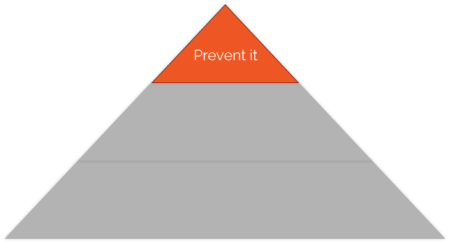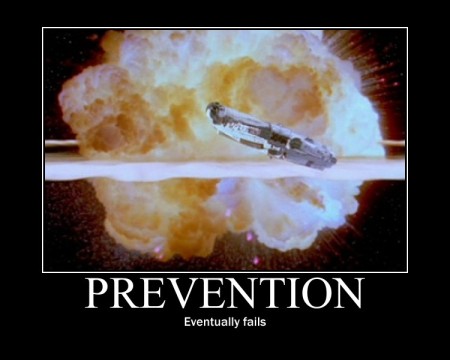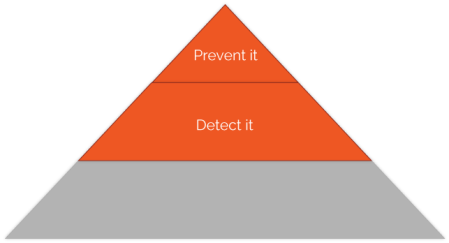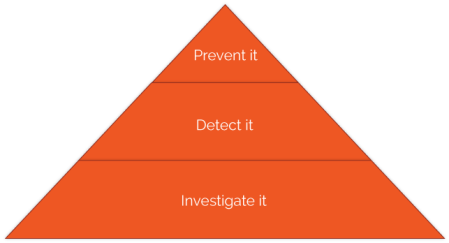I love it when a plan comes together
As defenders, we have many reasons to do our jobs. We want to comply with regulations, protect our employers (and protect our pay cheques!), and just maybe we enjoy the challenge despite the certain knowledge that someday an exploit with our name on it is going to smack us between the eyes.
The “why we do it” is therefore straightforward; what about the “how”? How do we defend? I don’t mean from a technical perspective – at a generic level, what are we trying to achieve?
There are certainly many answers to that question, but I quite like the idea that there are three mutually supporting objectives for defenders. The idea I’m presenting below is probably a little monitoring-centric, but then so am I!
At the top tier, there’s the “Defenders’ Utopia”, namely Prevent-It:
 It doesn’t matter what “It” is – if we can prevent all badness, we’ve won! Let’s patch stuff, pentest stuff, educate our users, harden our deployments, use SDL principles and products X, Y and Z to prevent all the badness, guaranteeing us “corporate security hero” status.
It doesn’t matter what “It” is – if we can prevent all badness, we’ve won! Let’s patch stuff, pentest stuff, educate our users, harden our deployments, use SDL principles and products X, Y and Z to prevent all the badness, guaranteeing us “corporate security hero” status.
Prevent-It is therefore our “Plan A”. Sadly, it’s not enough because Prevention Eventually Fails – we need a Plan B.
 If we can’t Prevent-It, Plan B should be to “Detect-It” in a timely fashion:
If we can’t Prevent-It, Plan B should be to “Detect-It” in a timely fashion:
 And no, third-party breach notification doesn’t count as “timely”! As well as responding to obvious indicators such as AV or IDS hits, we need to be proactive in detection by hunting through all of the instrumentation at our disposal looking for indicators like uncommon or never-before-seen events, unusual volumes of network traffic or event types, Bob logging in from Antigua when you know he’s in Scotland, etc. A solid ability to Detect-It will help you invoke the Intruder’s Dilemma.
And no, third-party breach notification doesn’t count as “timely”! As well as responding to obvious indicators such as AV or IDS hits, we need to be proactive in detection by hunting through all of the instrumentation at our disposal looking for indicators like uncommon or never-before-seen events, unusual volumes of network traffic or event types, Bob logging in from Antigua when you know he’s in Scotland, etc. A solid ability to Detect-It will help you invoke the Intruder’s Dilemma.
“Detect-It” is bigger than “Prevent-It” in the diagram because prevention is hard, and we are more likely to be able to detect things than we are to prevent them if we try hard enough. Attackers have more tactics at their disposal than defenders have preventative measures so you need to be as thorough and as business-tailored as you can be in your monitoring. Know your infrastructure in as much detail as possible in terms of the platform (e.g., MVC app on IIS8 behind a Cisco ASA) and make certain it’s behaving as expected. For a self-contained security team, this latter part might be hard – I’d possibly venture the opinion that an app’s functional spec might be a useful thing for the security team to have. Should app X be sending emails? Doing FTP transfers? Talking to SkyDrive? If the security team don’t understand these details, they may miss things.
Eventually, you’ll likely run up against an attacker who slips past detection and conjures up the defenders’ nightmare of third-party breach notification – you’ve been compromised, you didn’t notice it happen, and now you’re front page news. Plan B has failed – your final recourse is Plan C:
If we can’t Prevent-It, and we didn’t Detect-It then we have to maintain the ability to Investigate-It. This bit’s biggest because it represents your gathering of logs, network traffic data and other indicators – your monumental programme of “hay collection” (the Detect-It part can be thought of as a “hay removal” process whose output is needles, if you follow my metaphor).
Even boring, routine logs may be worth their weight in gold when Investigating-It – collect as much as is feasible and legal. Even if we don’t have the resource to actually look at all the collected logs as a matter of course, at least we’ve got a huge pool of evidence to trawl through as part of the Incident Response process.
We can also use Investigate-It for retrospective analysis. If a new set of IOCs (Indicators of Compromise) comes to light, we can check them against what we’ve collected so far. Investigate-It also supports your corporate forensic readiness plan – knowing what information you need as part of IR, where to get it, and what you can get quickly without outside help is key.
Stairway to Heaven
If our org has sufficient resources we can move back up the stack, leveraging each tier to improve the one above. If we have an excellent capability to Investigate-It, it means we can improve our ability to Detect-It by hunting through the collected logs in different ways, producing more insightful reports/alerts/dashboards that pull together many disparate log sources. Lessons learned as part of Investigate-It can be incorporated into Detect-It – make sure that the indicators that were missed this time won’t be missed next time.
Moving up again, improving our ability to Detect-It can improve our ability to Prevent-It because we may discover things we don’t like that we can put a stop to before they become a problem (e.g. people emailing confidential docs to their personal email account so they can “work on them from home”, people logging in as local admin, people running apps you don’t like, why is there an active Bluetooth serial port on the CEO’s MacBook, etc) or we may even discover Existing Badness that we can zap.
So now we’re back at the top of the diagram, hopefully in better stead than before we started. Like I say, it’s a monitoring-centric way of looking at things, but if you’re in the game hopefully it’s an interesting perspective!

 Alec Waters is responsible for all things security at Dataline Software, and can be emailed at alec.waters@dataline.co.uk
Alec Waters is responsible for all things security at Dataline Software, and can be emailed at alec.waters@dataline.co.uk


9 January, 2014 at 23:00
Reblogged this on The Unsuspecting Bit.